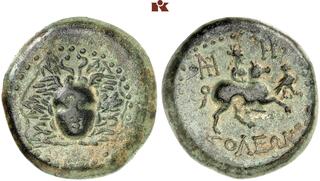| Fritz Rudolf Künker GmbH & Co. KG > Auction 402 | Auction date: 14 March 2024 |
| Lot number: 473 Price realized: 110 EUR (Approx. 120 USD) Note: Prices do not include buyer's fees. | Show similar lots on CoinArchives Find similar lots in upcoming auctions on |
| Lot description: CILICIA. SOLOI. Æs, 2./1. Jahrhundert v. Chr.; 15,82 g. Aegis mit geflügeltem Gorgoneion in der Mitte//Aphrodite reitet r. auf Stier, davor Eule. SNG France 2, 1199 var.; SNG Levante 872 var. Dunkelgrüne Patina, min. Doppelschlag, sehr schön Exemplar der Auktion Sternberg 17, Zürich 1986, Nr. 176 und der Auktion Giessener Münzhandlung 100, München 1999, Nr. 189. Besonderes Interesse kann diese Bronze aus dem 2./1. Jhdt. v. Chr. beanspruchen, die auf der Vorderseite ein Gorgoneion zeigt, auf der Rückseite eine stierreitende Frau. Eine Schale mit Gorgoneion soll Amphilochos dem Heiligtum der Athena Lindia auf Rhodos geweiht haben (Higbie 2003, 38 f. und 126 f.). Das Gorgonenmotiv mag auch damit zu tun haben, dass nach mythischen Traditionen der argivische Heros Perseus die Gorgo in Kilikien enthauptet haben soll. Die stierreitende Frau wird als Astarte/Aphrodite oder als Europa gedeutet. In dieser Zeit dürfte sie aber in einer griechischen Stadt eher mit Europa identifiziert worden sein als mit der orientalischen Göttin. [JN] Of particular interest is this bronze from the 2nd/1st century BC. It shows a gorgoneion on the obverse and a woman riding a bull on the reverse. Amphilochos is said to have dedicated a bowl with a gorgoneion to the sanctuary of Athena Lindia on Rhodes (Higbie 2003, 38 f. and 126 f.). The Gorgon motif may also have something to do with the fact that, according to mythical traditions, the Argive hero Perseus is said to have beheaded the Gorgo in Cilicia. The bull-riding woman is interpreted as Astarte/Aphrodite or Europa. In a Greek city at that time, however, she was more likely to have been identified with Europa than with the oriental goddess. [JN] Estimate: 75 EUR |  |



